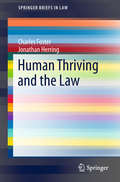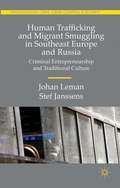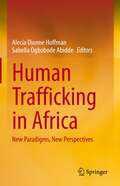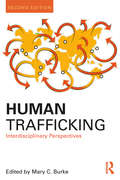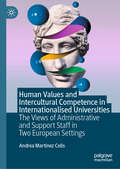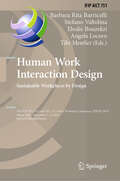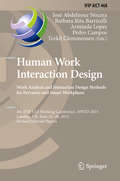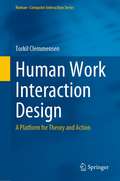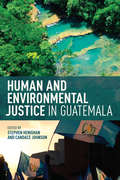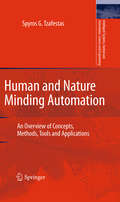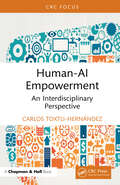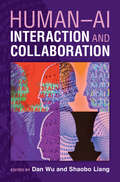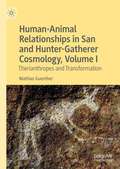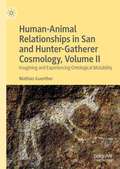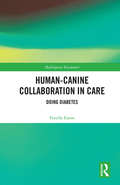- Table View
- List View
Human Thriving and the Law (SpringerBriefs in Law)
by Charles Foster Jonathan HerringThe idea of the Good Life – of what constitutes human thriving, is, implicitly, the foundation and justification of the law. The law exists to hold societies together; to hold in tension the rights of individuals as against individuals, the rights of individuals as against various types of non-humans such as corporations (and vice versa), and the rights of individuals individuals as against the state (and vice versa). In democratic states, laws inhibit some freedoms in the name of greater, or more desirable freedoms. The only justification for law is surely that it tends to promote human thriving. But what is the Good Life? What does it mean to live a thriving life? There has been no want of discussion, at least since the great Athenians. But surprisingly, since human thriving is its sole raison d’etre, the law has been slow to contribute to the conversation. This book aims to start and facilitate this conversation. It aims to: -make lawyers ask: ‘What is the law for?’, and conclude that it is to maximise human thriving -make lawyers ask: ‘But what does human thriving mean?’ -make judges and advocates ask: ‘How can a judgment about the best interests of a patient be satisfactory unless its basis is made clear?’
Human Tissue in the Realist Novel, 1850-1895 (Palgrave Studies in Literature, Science and Medicine)
by Ben MooreThis Pivot engages with current debates about anthropocentrism and the Anthropocene to propose a reappraisal of the realist novel in the second half of the nineteenth century. Through three case studies, it argues for ‘human tissue’ as a conceptual tool for reading that brings together biology, literature and questions of layering. This new approach is shown to be especially salient to the Victorian period, when the application of ‘tissue’ to biology first emerges. The book is distinctive in bringing together theoretical concerns around realism and the Anthropocene – two major topics in literary criticism – and presenting a new methodology to approach this conjunction, demonstrated through original readings of Charles Kingsley, George Eliot, and Emile Zola and two English-language writers he influenced (George Moore and Vernon Lee).
Human Trafficking and Migrant Smuggling in Southeast Europe and Russia: Learning Criminal Entrepreneurship and Traditional Culture (Transnational Crime, Crime Control and Security)
by Johan Leman Stef JanssensThrough unprecedented access to over 100 court files and sentences, and interviews with police and security personnel in both origin and destination countries, this book provides the most comprehensive exploration to date of human trafficking and migrant smuggling in Eastern Europe and Russia.
Human Trafficking in Africa: New Paradigms, New Perspectives
by Sabella Ogbobode Abidde Alecia Dionne HoffmanThis edited volume examines the contemporary practice of human trafficking on the African continent. It investigates the scourge of human trafficking in Africa from the broader international and regional perspectives as well as from a country-specific context. Written by a multi-disciplinary panel of academics and practitioners, the book is divided into three sections that highlight a wide range of issues. Section One examines the theoretical and legal challenges of trafficking. Section Two focuses on the regional and nation-state perspectives of human trafficking along with selected cases of trafficking. Section Three highlights the impact of trafficking on youth, with specific attention given to child soldiering and female victims of trafficking. Providing a multi-faceted approach to a problem that crosses multiple disciplines, this volume will be useful to scholars and students interested in African politics, African studies, migration, human rights, sociology, law, and economics as well as members of the diplomatic corps, governmental, intergovernmental, and non-governmental organizations.
Human Trafficking: A Complex Phenomenon of Globalization and Vulnerability
by Natividad Gutiérrez Chong and Jenny Bryson ClarkIn the post-Cold War era, economic globalization has resulted in the buying and selling of human beings. Poverty, social instability, lawlessness, gender biases, and ethnic hostility have entrapped millions in the world of modern day slavery, with the result that human trafficking is one of the fastest growing criminal industries in the world. Every year, men, women, and children from across the globe are transported within or across borders for the purpose of forced labor and sexual exploitation. Despite the plethora of journalistic articles written on human trafficking there is a need for more rigorous academic analysis of the phenomenon. Although groups from many different ideologies have embraced policies to end human trafficking, there are still many gaps and unanswered questions, particularly with regard to the amount of, and nature of the phenomenon. This book provides an insight into the complexity of human trafficking by addressing both how the scope of globalization impacts the sex industry and forced labor, and how vulnerability is a growing cause of human trafficking, affecting traditional diasporic and migratory patterns. This book was originally published as a special issue of the Journal of Intercultural Studies.
Human Trafficking: Interdisciplinary Perspectives
by Mary C. BurkeThe practice of one human being exploiting another in slavery-like conditions is not new. Today, it is called human trafficking. Social, political, and economic forces over the past 60 years have changed how and why this human rights abuse occurs. In order to solve this or any social problem, it is important that it is fully understood. With a range of contributing subject experts from different disciplines and professions, this text comprehensively explains human trafficking as it exists and is being addressed in the twenty-first century. Human Trafficking is essential reading for professionals working in many fields, including law enforcement, human services, and health care, and for concerned citizens interested in human rights and how to make a difference in their communities. This book is also intended for use in undergraduate and graduate interdisciplinary courses in human trafficking. A bank of test items applicable to each article in the book is available to instructors interested in selecting this edition for course use. Simply send an e.mail to the publisher at saleshss@taylorandfrancis.com
Human Trafficking: Interdisciplinary Perspectives (Criminology and Justice Studies)
by Mary C. BurkeWith a range of experts from different disciplines and professions, this text comprehensively explains human trafficking as it exists and is being addressed in the twenty-first century. The first section gives an overview of the issue and contextualizes it within a human rights and historical framework. The second section provides the reader with more detailed, interdisciplinary information about trafficking. The third section, which contains a chapter written by a former FBI agent, focuses on the anti-trafficking movement and addresses international responses to the problem, as well as considerations for working with victims. Human Trafficking closes with a chapter about how trafficking is being addressed and how individuals, larger social groups, and organizations can get involved in putting an end to the crime and to helping survivors. Human Trafficking is essential reading for professionals in law enforcement, human services, and health care, and for concerned citizens interested in human rights and making a difference in their communities. This book is also intended for use in undergraduate and graduate interdisciplinary courses in human trafficking.
Human Trafficking: Interdisciplinary Perspectives (Criminology and Justice Studies)
by Mary C. BurkeIn Human Trafficking: Interdisciplinary Perspectives experts from a wide range of disciplinary and professional backgrounds provide a uniquely comprehensive understanding of human trafficking in the twenty-first century. Chapter authors consider historical, sociocultural, legal, public health, human rights, and psychological aspects of this issue. New chapters address important topics such as racism, child soldiers, organ trafficking, and the role of technology and the banking industry in trafficking. The third edition also explores the ways in which institutionalized oppression of people of color, Native Americans, and those in the LGBTQ+ community can underlie vulnerability of these populations to being trafficked. Human Trafficking is essential reading for professionals in law enforcement, human services, and health care, and for concerned citizens interested in human rights and making a difference in their communities. This book is also intended for use in undergraduate and graduate interdisciplinary courses in human trafficking.
Human Values and Intercultural Competence in Internationalised Universities: The Views of Administrative and Support Staff in Two European Settings
by Andrea Martínez CelisThis book investigates the perceptions of the administrative and support staff at two universities (one in Spain, the other in the Netherlands) regarding internationalisation in their institutions and their own perceived intercultural competence within their contexts. Using the Schwartz value system, the author aims also to understand and explore how human values relate to attitudes and intercultural competence more broadly. The book argues for the importance of intercultural competence of administrative and support staff in internationalised universities, as well as their key role as essential agents in promoting internationalisation. The author proposes an interdisciplinary method to evaluate intercultural competence from an emic perspective—through questionnaires and interviews—and from an etic perspective—analysing participants’ discursive constructions to reveal their human values. This volume will be of interest to academics and practitioners in fields such as linguistics, intercultural competence, intercultural and cross-cultural studies, internationalisation of higher education, and sociology.This book investigates the perceptions of the administrative and support staff at two universities (one in Spain, the other in the Netherlands) regarding internationalisation in their institutions and their own perceived intercultural competence within their contexts. Using the Schwartz value system, the author aims also to understand and explore how human values relate to attitudes and intercultural competence more broadly. The book argues for the importance of intercultural competence of administrative and support staff in internationalised universities, as well as their key role as essential agents in promoting internationalisation. The author proposes an interdisciplinary method to evaluate intercultural competence from an emic perspective—through questionnaires and interviews—and from an etic perspective—analysing participants’ discursive constructions to reveal their human values. This volume will be of interest to academics and practitioners in fields such as linguistics, intercultural competence, intercultural and cross-cultural studies, internationalisation of higher education, and sociology.
Human Well-Being and Policy in South Asia (Human Well-Being Research and Policy Making)
by Vijay Kumar ShrotryiaThis book explores human well-being in South Asia from a policy dimension. It discusses the cultural history and diversity of the region in order to highlight major priority areas of public policy to improve people’s quality of life. The huge gap between economic development and human development, in areas such as education, health and income, is a concern for policymakers, researchers and other stakeholders. The book helps develop a strong argument for a shift of focus of state’s expenditures aimed at improving human well-being, and assesses public policy initiatives from the perspectives of the stakeholders such as the state, the market, households, civil society as well as NGOs and agencies involved in this development mission. As such it is of great interest to scholars in the field of quality-of-life and well-being research and policymakers at national and international level.
Human Work Interaction Design. Sustainable Workplaces by Design: IFIP WG 13.6 and WG 13.5 Joint Working Conference, HWID 2024, Milan, Italy, September 5–6, 2024, Revised Selected Papers (IFIP Advances in Information and Communication Technology #751)
by Barbara Rita Barricelli Stefano Valtolina Tilo Mentler Elodie Bouzekri Angela LocoroThis book constitutes the refereed proceedings of the 7th IFIP WG 13.6 and WG 13.5 Joint Working Conference on Human Work Interaction Design, HWID 2024, held in Milan, Italy, during September 5-6, 2024. The 15 full papers were carefully reviewed and selected from 23 submissions.HWID 2024 proposed to explore sustainability through Human Work Interaction Design lens encompassing its environmental, economical, ethical and social dimensions.
Human Work Interaction Design. Work Analysis and Interaction Design Methods for Pervasive and Smart Workplaces
by José Abdelnour Nocera Barbara Rita Barricelli Arminda Lopes Pedro Campos Torkil ClemmensenThis book constitutes the thoroughly refereed post-conference proceedings of the 4th IFIP WG 13. 6 Working Conference on Human Work Interaction Design, HWID 2015, held in London, UK, in June 2015. The 15 revised full papers presented were carefully selected for inclusion in this volume. The papers reflect many different areas and address many complex and diverse work domains, focusing on the integration of work analysis and interaction design methods for pervasive and smart workplaces. They are organized in the following sections: methodologies; environment, and specific contexts.
Human Work Interaction Design: A Platform for Theory and Action (Human–Computer Interaction Series)
by Torkil ClemmensenAn approach to socio-technical HCI called Human Work Interaction Design (HWID) emerged around 2005. It has grown steadily, and now is the time for sharing this research with a wider audience. In this book, the HWID approach is used to discuss socio-technical HCI theory, cases, methods, and impact. The book introduces HWID as a multi-sided platform for theorizing about socio-technical HCI work design in the digital age. It presents design cases that illustrate the design of socio-technical relations, provides specific advice for researchers, consultants, and policy makers, and reflects on the open issues related to theorizing about sociotechnical HCI. The benefits of HWID include that it meets the requirement of taking both the social and the technical into account, while focusing strongly on the relationship between the social and the technical. In addition, it is truly international and explicitly considers local cultural, organizational, and technological contexts.
Human Wrongs: British Social Policy and the Universal Declaration of Human Rights
by T. J. ColesA devastating analysis of modern Britain. Britain is a forward-thinking, human-rights protecting beacon of democracy, right? Think again! Written in time for the 70th anniversary of the Universal Declaration of Human Rights, this book is a documented exposé of Britain's domestic human rights abuses under successive governments from the year 2000 to the present. It covers the deaths of the 20,000 pensioners a year who can't afford heating, the 40,000 people who succumb to air pollution each year, the limits on freedom of speech (including libel law), mass surveillance of Britons by the deep state, and much, much more. By comparing Britain to other rich countries on issues as diverse as infant mortality, child wellbeing, ethnic rights, and union membership, Human Wrongs reveals just how anti-human the British system really is for people of a certain class, gender, disability and/or ethnicity.
Human and Environmental Justice in Guatemala
by Stephen Henighan Candace JohnsonIn 1996, the Guatemalan civil war ended with the signing of the Peace Accords, facilitated by the United Nations and promoted as a beacon of hope for a country with a history of conflict. Twenty years later, the new era of political protest in Guatemala is highly complex and contradictory: the persistence of colonialism, fraught indigenous-settler relations, political exclusion, corruption, criminal impunity, gendered violence, judicial procedures conducted under threat, entrenched inequality, as well as economic fragility. Human and Environmental Justice in Guatemala examines the complexities of the quest for justice in Guatemala, and the realities of both new forms of resistance and long-standing obstacles to the rule of law in the human and environmental realms. Written by prominent scholars and activists, this book explores high-profile trials, the activities of foreign mining companies, attempts to prosecute war crimes, and cultural responses to injustice in literature, feminist performance art and the media. The challenges to human and environmental capacities for justice are constrained, or facilitated, by factors that shape culture, politics, society, and the economy. The contributors to this volume include Guatemalans such as the human rights activist Helen Mack Chang, the environmental journalist Magalí Rey Rosa, former Guatemalan Attorney General Claudia Paz y Paz, as well as widely published Guatemala scholars.
Human and Machines: Philosophical Thinking of Artificial Intelligence (Human Intelligence)
by Yike Guo Jun GuThis book shares Chinese scholars’ philosophical views on artificial intelligence. The discussions range from the foundations of AI—the Turing test and creation of machine intelligence—to recent applications of AI, including decisions in games, natural languages, pattern recognition, prediction in economic contexts, autonomous behaviors, and collaborative intelligence, with the examples of AlphaGo, Microsoft’s Xiao Bing, medical robots, etc. The book’s closing chapter focuses on Chinese machines and explores questions on the cultural background of artificial intelligence. Given its scope, the book offers a valuable resource for all members of the general public who are interested in the future development of artificial intelligence, especially from the perspective of respected Chinese scholars.
Human and Nature Minding Automation
by Spyros G. TzafestasThis book examines the "symbiosis" of automation and technology with the human and the nature towards the ultimate goal of assuring global sustainability. Throughout the years a variety of approaches, technologies and practices have been produced in the direction of achieving human-and nature-minding automation and industrial activity. In this book an attempt is made, for the first time, to present in a cohesive and consolidated way an overview of all these issues together, and show how they combine to provide human-and nature-minding (green) systems. Human-minding automation is possible by employing concepts and techniques from the human factors and ergonomics fields, including job satisfaction, human-friendly interfaces, and human values, whereas nature-minding industrial activity and human development can be achieved by considering as a whole the human, economic, natural and cultural resources in the short and long term. In particular, nature-minding design selects the production methods and technologies that have the minimum impact to the nature. The book is intended for use both as a free reference conceptual book, and as general introductory book in relevant teaching and research environments.
Human and Organisational Factors: Practices and Strategies for a Changing World (SpringerBriefs in Applied Sciences and Technology)
by Corinne Bieder Claude Gilbert Benoît Journé Hervé LarocheThis open access book addresses several questions regarding the implementation of human and organisational factors (HOF) so that recent improvements in industrial safety can be built upon. It addresses sources of frustration in senior management with high expectations of operational recommendations and disquiet on the part of HOF specialists struggling to have an impact on high-level decision making. The brief explores these issues with an emphasis on examples and lessons learned based on the experience of its authors, who come from different academic disciplines and various industrial sectors such as oil and gas, energy and transportation. It then offers some ways forward for a better consideration of HOF in hazardous companies with a view of promoting safety and facing challenges in a rapidly changing world.
Human and Robot Hands
by Matteo Bianchi Alessandro MoscatelliThis booklooks at the common problems both human and robotic hands encounter when controllingthe large number of joints, actuators and sensors required to efficientlyperform motor tasks such as object exploration, manipulation and grasping. The authorsadopt an integrated approach to explore the control of the hand based onsensorimotor synergies that can be applied in both neuroscience androbotics. Hand synergies are based on goal-directed, combined muscle andkinematic activation leading to a reduction of the dimensionality of the motorand sensory space, presenting a highly effective solution for the fast and simplifieddesign of artificial systems. Presented intwo parts, the first part, Neuroscience, provides the theoretical andexperimental foundations to describe the synergistic organization of the humanhand. The second part, Robotics, Models and Sensing Tools, exploits theframework of hand synergies to better control and design robotic hands andhaptic/sensing systems/tools, using a reduced number of control inputs/sensors,with the goal of pushing their effectiveness close to the natural one. Human andRobot Hands provides a valuable reference for students, researchers anddesigners who are interested in the study and design of the artificial hand.
Human-AI Empowerment: An Interdisciplinary Perspective
by Carlos Toxtli-HernándezAs artificial intelligence (AI) advances, the question of how AI can empower humans over the long term has become increasingly important. This book, Human-AI Empowerment (HAIE), provides a timely exploration of strategies for aligning AI with long-term human goals, ensuring that AI acts as an empowering force across multiple dimensions. Drawing on interdisciplinary research from fields such as AI, HCI, psychology, education, economics, and social science, the book develops comprehensive frameworks for studying and optimizing AI’s impact on human empowerment. HAIE investigates empowerment from a human-centered computing (HCC) perspective, examining how AI systems can track and adapt to progressively achieve long-term goals. The book explores techniques for fostering a mutually beneficial human-AI synergy, delving into AI Empowerment approaches, applicable Human-Computer Interaction methods for long-term engagement, and insights from various disciplines on long-term goal management. Through integrative frameworks, empirical evidence, and ongoing work in the field, this volume informs academics and practitioners seeking to harness AI as a transformative technology for concretely empowering humanity. This book highlights the need for comprehensive approaches to understanding and shaping the future of human-AI collaboration, maximizing its potential to expand human possibilities and support the pursuit of mid-term and long-term goals.
Human-AI Interaction and Collaboration
by Dan Wu Shaobo LiangThe integration of AI into information systems will affect the way users interface with these systems. This exploration of the interaction and collaboration between humans and AI reveals its potential and challenges, covering issues such as data privacy, credibility of results, misinformation, and search interactions. Later chapters delve into application domains such as healthcare and scientific discovery. In addition to providing new perspectives on and methods for developing AI technology and designing more humane and efficient artificial intelligence systems, the book also reveals the shortcomings of artificial intelligence technologies through case studies and puts forward corresponding countermeasures and suggestions. This book is ideal for researchers, students, and industry practitioners interested in enhancing human-centered AI systems and insights for future research.
Human-Animal Relationships in San and Hunter-Gatherer Cosmology, Volume I: Therianthropes and Transformation
by Mathias GuentherExploring a hitherto unexamined aspect of San cosmology, Mathias Guenther’s two volumes on human-animal relations in San cosmology link “new Animism” with Khoisan Studies, providing valuable insights for Khoisan Studies and San culture, but also for anthropological theory, relational ontology, folklorists, historians, literary critics and art historians. In Volume I, therianthropes and transformations, two manifestations of ontological mutability that are conceptually and phenomenologically linked, are contextualized in broader San myth. Guenther explores the pervasiveness of human-animal hybridity and transformation in San expressive culture (myth, stories and storytelling, ludic dancing and art, ancestral rock art and contemporary easel art), ritual (trance dance curing, female and male rites of passage) and hunting. Transformation is shown to be experienced by humans, particularly via rituals and dancing that evoke animal identity mergers, but also by hunters who may engage with their prey animals in terms of sympathy and inter-subjectivity, particularly through the use of “hunting medicines.”
Human-Animal Relationships in San and Hunter-Gatherer Cosmology, Volume II: Imagining and Experiencing Ontological Mutability
by Mathias GuentherExploring a hitherto unexamined aspect of San cosmology, Mathias Guenther’s two volumes on human-animal relations in San cosmology link “new Animism” with Khoisan Studies, providing valuable insights for Khoisan Studies and San culture, but also for anthropological theory, relational ontology, folklorists, historians, literary critics and art historians. Building from the examinations of San myth and contemporary culture in Volume I, Volume II considers the experiential implications of a cosmology in which ontological mutability—ambiguity and inconstancy—hold sway. As he considers how people experience ontological mutability and deal with profound identity issues mentally and affectively, Guenther explores three primary areas: general receptiveness to ontological ambiguity; the impact of the experience of transformation (both virtual/vicarious and actual/direct); and the intersection of the mythic, spirit world with reality. Through a comparative consideration of animistic cosmology amongst the San, Bantu-speakers and the Inuit of Canada’s eastern Arctic, alongside a discussion of animistic currents in Western humanities and ethology, Guenther clearly paints the relative strengths and weaknesses of New Animism discourse, particularly in relation to San ontology and cosmology, but with overarching relevance.
Human-Animal Relationships in Times of Pandemic and Climate Crisis: Multispecies Sociology for the New Normal (Multispecies Encounters)
by Zoei Sutton Josephine BrowneThis book situates sociological research as a vital tool for understanding, and responding to, the multispecies entanglements that cause, inform and arise from states of crisis involving the environment, climate and zoonotic disease transmission. Considering the consequences of a range of multispecies engagements that challenge the perceived distinction between the social worlds of humans and other animals, it explores the themes of crisis through a range of studies, including ecological disturbance, consumer culture, intensive farming and interspecies relations in urban life. With attention to central questions about life in ‘the now normal’, including the extent to which a human–animal perspective can contribute to our understanding of pandemics, the ideological foundations of mainstream norms for human–animal relations and the scope of current and emerging social movements for reshaping human–animal relations, this volume represents a timely and important call for a sociological vision to embrace the implications of a multispecies planet and to expand the concepts of inclusion and justice. A reconsideration of the human–animal relation that seeks both to revise sociology’s past and inform its future, Human–Animal Relationships in Times of Pandemic and Climate Crises will appeal to scholars across the social sciences with interests in human–animal relations and the environment.
Human-Canine Collaboration in Care: Doing Diabetes (Multispecies Encounters)
by Fenella EasonAdopting an anthrozoological perspective to study the participation of non-human animals in regimes of care, this book examines the use of canine scent detection to alert 'hypo-unaware' individuals to symptoms of human chronic illness. Based on ethnographic research and interviews, it focuses on the manner in which trained assistance dogs are able to use their sense of smell to alert human companions with Type 1 diabetes to imminent hypoglycaemic episodes, thus reducing the risk of collapse into unconsciousness, coma or, at worst, death. Through analyses of participant narrations of the everyday complexities of 'doing' diabetes with the assistance of medical alert dogs, the author sheds light on the way in which each human-canine dyad becomes acknowledged as a team of ‘one’ in society. Based on the concept of dogs as friends and work colleagues, as animate instruments and biomedical resources, the book raises conceptual questions surrounding the acceptable use of animals and their role within society. As such, this volume will appeal to scholars across the social sciences with interests in human-animal interactions and intersections. It may also appeal to healthcare practitioners and individuals interested in innovative multispecies methods of managing chronic illness.
